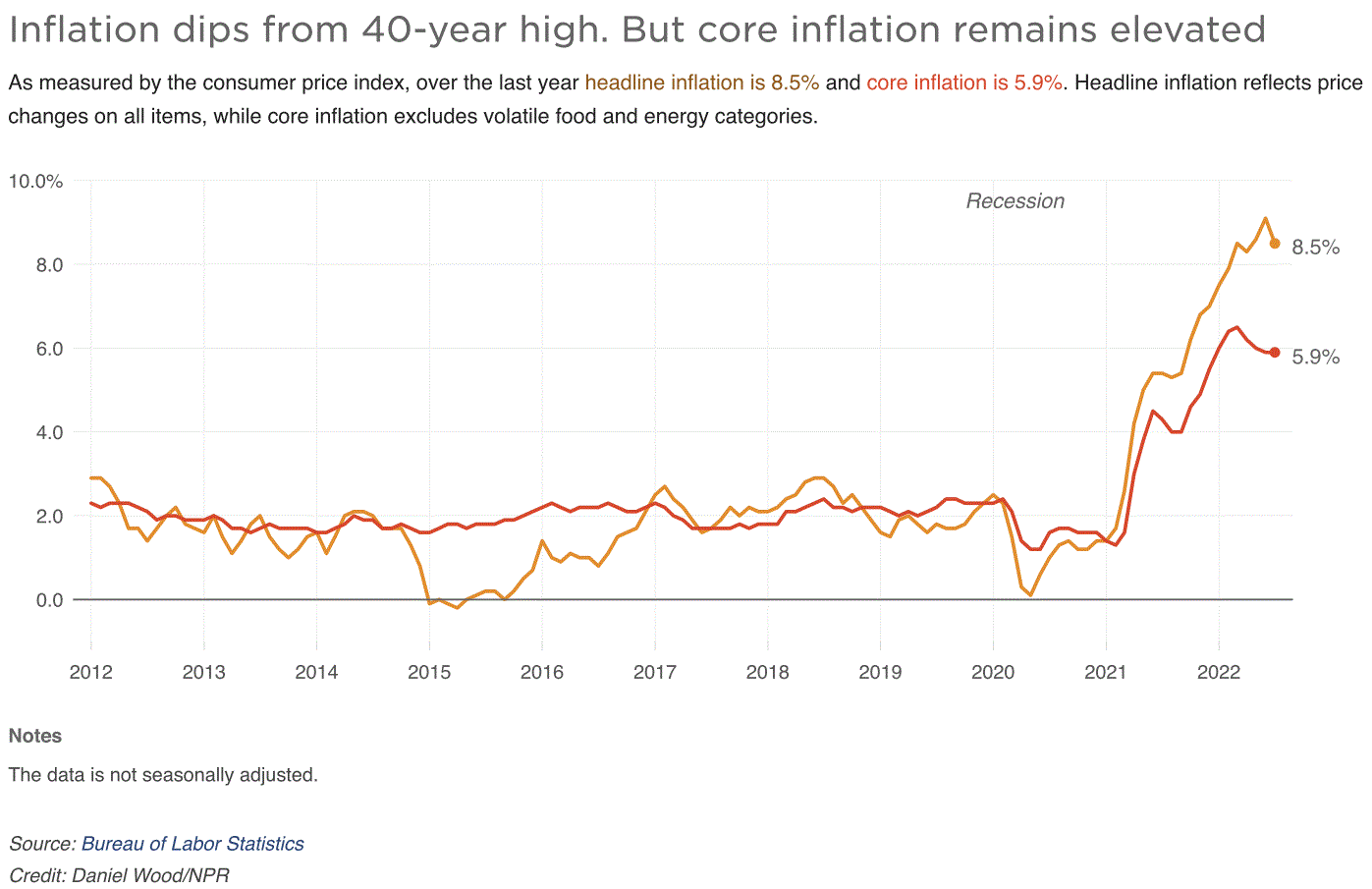
Updated August 10, 2022 - NPR
Scott Horsley
When it comes to inflation, the good news is that gas prices are dropping. The bad news is that other costs continue to climb faster than wages, and that's putting a strain on many family budgets across the country.
The Labor Department reported Wednesday that annual inflation dipped to 8.5% in July, from 9.1% the month before, thanks in part to a steep drop in gasoline prices.
Meanwhile, falling prices at the pump left the consumer price index unchanged between June and July. The average price of gasoline reached $4.01 a gallon on Wednesday, according to AAA, down sharply from the record high of $5.01 a gallon on June 14.
While that's some relief, Americans are still feeling squeezed by higher prices for other goods and services.
"Sure, that's better than $5," says Spencer Sutton of Newport, Pa. of today's lower gas price. "But compared to what we were paying before everything started with the war in Ukraine, it's still a high cost."
Sutton also worries about the high cost of groceries and especially housing. To save on expenses while his wife finishes nursing school, the couple moved in with his mother.
"As a 30-year-old millennial, I did not think I would still be living with my mom, with my brother and my wife," Sutton says. "It's certainly not the most ideal arrangement, but with what's going on in today's day and age, you have to do what you have to do."
Housing costs ・up 5.7% from a year ago ・are a growing factor behind inflation. Rising rents and home prices are reflected only gradually in the Labor Department data, and those costs tend to be more persistent than volatile food and energy prices.
"That's moving in the wrong direction for the Federal Reserve," says Diane Swonk, chief economist for KPMG.
Annual core inflation, which excludes volatile food and energy prices, held steady in July at 5.9%.
But core prices rose just 0.3% between June and July ・the smallest increase in four months. Investors welcomed the sign that inflation may be cooling. The Dow Jones Industrial Average rose more than 450 points in the first hour of trading.
Still, prices are rising faster than wages, chipping away at workers' purchasing power.
Penelope Valdespino switched this year from a retail job to a higher-paying post with the school district in San Antonio, Texas. Her larger paycheck is rapidly gobbled up, though, by rising prices.
"I finally moved over to a different job where yes, I'm going to be getting paid $3 or $4 more an hour," she says. "That's awesome, but to catch up and keep everything in order is still a challenge in this climate right now."
Valdespino welcomes the drop in gasoline prices, but says she's still careful to limit unnecessary car trips. And she's watching her pennies at the grocery store, where prices have jumped 13.1% from a year ago.
"We're being really careful in how much meat we buy," she says.
Sutton, who works for a dental insurance company, also got a raise this year, but says the money doesn't stretch as far as it used to.
"It wasn't enough to combat inflation and the rising cost of food," he says. "It's tough to get to the end of the week before you get paid and you're out of food and you're digging out of the freezer to try to find something."
Average wages in July were up 5.2% from a year ago ・well short of the inflation rate.
Higher wages also complicate the Federal Reserve's efforts to fight inflation.
"We know how painful inflation is, especially for those living paycheck to paycheck," Fed chairman Jerome Powell said last month.
The Fed is trying to bring soaring prices under control by aggressively raising interest rates in an effort to tamp down demand.
But the Fed's task grew more challenging after last week's better-than-expected report on the labor market, which showed employers added 528,000 jobs last month.
"If those numbers are to be believed, we generated over a half-million new paychecks in the month of July, which is a lot of extra income," Swonk at KPMG says. "Even if individuals feel like they're losing ground relative to inflation, that extra income is supporting demand," keeping upward pressure on prices.
Before Wednesday's inflation report, many observers expected the central bank to approve another, jumbo interest rate increase of 0.75 percentage points at its next meeting in September, matching the rate hikes in June and July. After the report, oddsmakers tilted towards a smaller rate increase of 0.5 percentage points.
The sharp drop in gasoline prices may help curb inflation in another way.
Falling prices at the pump not only lowered July's headline inflation rate, but also appeared to reduce people's concerns about future inflation.
That's important because if people believe prices will keep climbing out of control, that can become a self-fulfilling prophecy.
A new survey by the Federal Reserve Bank of New York finds people's expectations of inflation one and three years into the future fell sharply between June and July, just as gas prices were coming down.
Swonk says gas prices have an outsize impact on people's attitudes about the economy, even though other expenses like food and rent make up a bigger part of the typical household budget.
"Even if you don't drive, you walk or drive by a gas station," Swonk says. "It's something we all notice, front and center, every day."